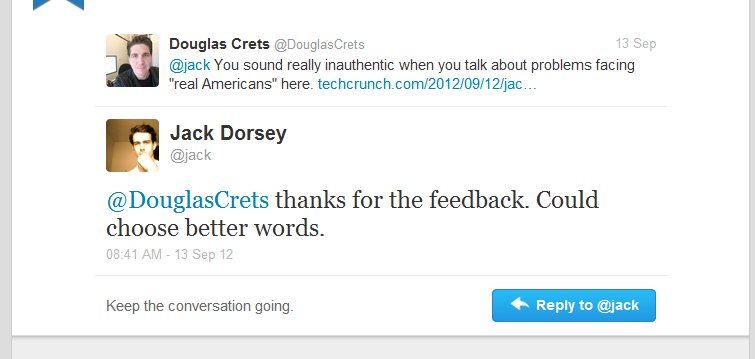Caution: Don't Take the Bus in the Midwest by Ahmed Siddiqui
Jack Dorsey is right about one thing, there is a bubble, but riding the bus may not be the most efficient means to disrupting the country's -- and Silicon Valley's -- biggest problem. It is far too aware that it is a source -- if not the source -- for innovation in America's economy.
Does riding a bus help solve America's, and the world's global economic problems, and lead to disruptive innovation? It is a good question, but Dorsey's descriptoin of why he does it, and what he hopes to achieve with it probably did not set the proper tone, and it may have actually done more to describe the problem Dorsey says he wishes to fix than show us a way to fix it, something that Dorsey admitted to when he tweeted with Microsoft BizSpark community manager Douglas Crets recently, after an article was written about a keynote he gave at TechCrunch Disrupt.
During last week's TechCrunch Disrupt, Twitter co-founder Jack Dorsey said that he took the bus through the Tenderloin every day to keep in touch with the real Americans and their troubles. This comment sparked off a discussion in the blogosphere about whether this sentinment was genuine, and whether American problems really were a centering force in guiding entrepreneurs in their search for disruptive product-market fits.
Our regular guest blogger Ahmed Siddiui, a developer living in the Bay Area, has written his reaction to this.
---
I’ve been thinking a lot about the recent TechCrunch article talking about Jack Dorsey riding the bus. It is quite interesting having him locate both Twitter and Square in the Tenderloin, but honestly speaking, it isn’t a great representation for what “Real America” looks like. First of all, I must mention that the Tenderloin has an excessive fecal matter problem that doesn’t exist in any major city outside of San Francisco. Also, the average American doesn’t have the LUXURY of taking the bus to work, because of urban sprawl. Most normal people in the United States have to drive to work; and most of them are driving Dodge Caravans or Toyota Camrys.
To get a good sense of the strange bubble we live in in the Bay Area, I’ve put together a simple comparison with some typical midwest sentiment (I’m originally from Minnesota, and I currently live in the Bay Area, and by no means am I knocking either, just comparing).
In true engineering style, I've created a table to go over some comparisons:
Bay Area |
Midwest (real america) |
|
News |
What did you think of Jack Dorsey's Speech? |
What did you think of Bill Clinton's Speech? |
Transportation |
Bart or Caltrain? |
Minivan or Sedan? |
Clothing |
I'm rocking my Startup Weekend T-Shirt |
I'm wearing my polo shirt from Macy's |
Coffee Shop |
I only drink Blue Bottle Coffee |
Wow! McDonalds has a Café now! |
Discussion at a coffee shop |
I can't believe startup XYZ got such a high valuation |
Did you know that your aunt got hip replacement surgery? |
On Twitter |
Did you see my #awesome tweet? |
WTF is Twitter? |
Places to work |
Square, Twitter, Google, Facebook |
Best Buy, Target, 3M, Cargill |
Definition of Small business |
Something Social/Local/Mobile tech thingy built over a weekend that doesn't make money |
Restaurant or convenience store that makes mad money but took years to build |
Places to eat for lunch |
Senior Sisig food truck, Osha Thai, Sushirrito |
Panera Bread, Jimmy Johns, Potbelly |
|
|
|
Real America is the Midwest, where people still use Windows and Dell laptops, wear decent clothes, talk about politics, build businesses that make money, and quite frankly don’t give a *** what TechCrunch says.
And to cap it off, disruptive innovation really is not as simple as observing how people interact in the world. You really need to find someone who has "bought" or "hired" a product and been frustrated with it. It's one thing to sit next to someone on the bus and feel like you are living something of their miserable existence. It's another to talk to them, to ask questions and to listen for the emotional physics that go into the choices they make, or don't make.
The interseting thing about Dorsey's point of view is that it's really about him stating the obvious in a rhetorical way -- he is not like the guy he is sitting next to on the bus. His product doesn't come from that guy's perspective or his experience. His product, Square, in this case, is really a disruptive innovation that he hopes will make life different than it is now.
That's a far cry from lean startup methodology, disruptive innovation, or cracking a market. What's really at play here is a class statement. Silicon Valley is a cultural hub, but also a bubble. It's a cultural milieu that is missing a little bit of the milieu.
Further reading: "Petty Inconveniences"
